Typically, US National Foil Champions are reasonably well documented, particularly in their home town. That doesn’t seem to be the case with Alfred R. Snyder, 1944 US foil champion.
Andy Shaw, the USA Fencing Historian and owner/proprietor/chief dog rescuer at the Museum of American Fencing, gave me the name Al Snyder some months back to see if I could dig up any cache of information, since Al’s fencing career began and ended (apparently) in the San Francisco Bay region. For good or ill, my thoughts about fencing history hone frighteningly close to Andy’s, as I had, not a week before, found the first and still best photo of Al Snyder in my collection and it’s a pretty unforgettable image. It’s the one at the top of the article, with Snyder on the left. What do you notice first? That Al Snyder was left handed?
Al Snyder, winner of the National foil title in 1944 and silver medalist in both 1943 and 1945, would have been on the US Olympic men’s foil team, if not for the lack of Olympics during the war years. I’m not sure that he would have been the first one-armed Olympian to compete in a sport at the Olympic Games but how many can there have been? If the timing of the world were different and he’d competed in the Olympic Games with only one arm, win, lose or draw, I’m guessing he would have become a household name for those giving any thought to humans overcoming physical challenges.
The first record of him as a fencer comes from Stanford University annuals. (This gets convoluted, so please bear with me.) He shows up in the Men’s Team photo in every edition of the Stanford Quad that I’ve seen, 1932 to 1937. By 1937 he was no longer on the team but the photo lists him as a graduate student and Pacific Coast Champion. His coach, possibly coaches, would have been Harry Maloney and/or Elwyn Bugge. Bugge was Maloney’s assistant in both tennis and fencing from 1928 on, a position he took up after his own Stanford graduation. One document in the Archive collection, a compilation of fencing coaches at various Bay Area clubs that was put together by Maestro Arthur Lane around 1955, indicates Bugge as the Stanford coach from 1927 and I’m guessing he started assisting while still a student. (The Stanford Quad lists him as starting in ’28. Lane’s source for the ’27 date was Elwyn Bugge, so I’m guessing the earlier date is correct.) Bugge remained the Stanford coach as late as 1957 and also coached for some years at the Olympic Club in San Francisco.
The 1934 photo from the Stanford Quad. In most of the photos from his Stanford years, Al Snyder made sure to line up with his right shoulder behind one of the other fencers, thus minimizing the chance for a casual observer to note his lack of a right arm.
Interestingly – and Andy Shaw and I have been going back and forth about this while I write my article – the earliest appearance of what seems to be Al Snyder at Stanford is actually 1929. I’m keeping in the previous paragraph with the dates as I wrote it, since that’s how I understood things when I began this piece. I had decided the guy listed as Snyder couldn’t be the same guy as the National Champion. His hairline was too different and he had a totally different face shape. (The available photos have lousy resolution, so it’s a tough read.) In the interim, Andy convinced me that the 1929-30 Snyder is the same guy as the later one. With one difference. He has two arms. In my original run-through of Stanford annuals, I couldn’t find a picture of the fencers from 1931. Just now, in going back through the 1931 annual one page at a time (thank you, e-yearbook!), I’ve come up with one. My problems with the 1929-30 Snyder are, I think, justified. On this new-to-me page, from 1931, there is another Snyder and this one not only has the right hairline, but he’s listed as a Freshman. I think this is him for sure. And with all of that, the 1931 Snyder also has a right arm and is holding a foil with it. In 1932, he only has his left arm and he’s switched over, perforce. So, and I’m pretty certain after all that, sometime between 1931 and 1932, Alfred R. Snyder, rising sophomore at Stanford University and future National Champion, lost his right arm.*
*I was wrong about the timing of the loss of his arm. Reader Mike Perka found an article from 1918 that seems to indicate that Snyder lost his right arm at the age of 5 during the celebration of the end of WW1. And I completely mis-interpreted the photo from the 1931 Stanford annual. I looked again more closely. Al’s left handed and hiding his right shoulder behind the fencer next to him. Here’s the article Mike found:
Ok, back to the story!
There are quite a number of articles in the Archive from various newspapers across multiple sources that mention Snyder’s name and accomplishments. From about 1937 on, he won just about every local competition he entered. And it is frequently noted that he had no defeats. There’s one where he did have a defeat or two but he’s in good company.
Al Snyder comes in for a bronze medal at a Nor Cal Open, finishing behind Olympic Club teammate Ferard Leicester and…. Helene Mayer! This event was the one that put Helene on the path to qualify to fence in the Men’s National Foil Championship. Unfortunately, the powers-that-be wouldn’t allow her to compete at the Pacific Coast Championships in the Men’s Open division since, had she won, she’d have been, by rule, qualified to fence at Nationals.
Snyder attended his first National Championship, as far as I can determine, in 1939. It’s possible he attended earlier ones but there are no extant records of the complete entries that I know of from this era. If copies of The Riposte magazine could be found, that would probably have them but the collection of issues to which I have access gets spotty prior to 1939. Snyder would have been qualified for Nationals in 1937 due to his winning the Pacific Coast Championships. In fact, he won two foil events at the ’37 PCCs. Because he was a relative newcomer, he participated in both the Intermediate and Open classification foil events, winning both.
By the time 1940 came around, Snyder was a well-known and respected opponent, if I can base that claim on the following excerpt from The Riposte magazine and the reporting from Nationals written by Dernell Every.
The previous year, 1939, Snyder was eliminated in the semi-finals, so this early exit in 1940 was a surprise.
Speaking of Dernell Every, the editor of The Riposte magazine, long-time New York fencer, National Champion and Olympic medalist (Bronze, Team Foil, 1932), in the October, 1940 issue of the magazine wrote about a cross-country-by-train trip that he took with stops in a number of cities where the local fencers came out to give him welcome. Here is the description of his stop in San Francisco.
“Recover” Al certainly did for the Nationals in 1941. It seems he made the trip to New York for Nationals a little earlier than his previous attempt, giving himself time to acclimate and fence locally for a little while before the competition. Sadly, in the fence off he was low man, ending the day in fourth place and out of the medals. And, as was decided shortly after, out of automatic qualification for the following year’s Nationals. Even though he’d finished the day in a tie for first, the powers decided to give AQ status for Nationals only to medalists. No matter. Al won a bunch of PCCs and took several second place spots behind his long-time SoCal rival, Edward Carfagno.
Dernell Every had one more interesting write up about Al Snyder in regards to a thrashing Al gave him during the 1941 foil Nationals:
Joe Louis fought Lou Nova on September 29, 1941. Louis successfully defended his heavyweight title, his 19th defense, earning a TKO over Lou “Cosmic Punch” Nova in the 6th round. Nova turned actor after his fight career ended. Born in Los Angeles in 1913, Nova was a vegetarian and practitioner of hatha yoga, which he learned from Pierre Bernard, a pioneering American yogi.
In the past week, I’ve spent a few hours at the San Francisco Public Library’s Main Branch on the sixth floor in Special Collections, attempting to see if there was more information available about Al Snyder, his life, work, whereabouts, anything. Since he was a longtime member of, and competitor for, the Olympic Club in SF, I first went through the library’s collection of “The Olympian” magazine, published by and for the Olympic Club. They don’t have anything like a complete run, but they had quite a few issues. About every other issue from the 1930s through the 1950s had a write-up about the goings-on in the fencing room. The only mention of Snyder came in the description of the results of two Olympic Club foil teams at the US Nationals in 1939 which were held on Treasure Island in San Francisco Bay. Snyder’s team took fourth. The other team, the team that bombed out in the first round, got their picture in the magazine. Wait, seriously? Aaargh! Why not a picture of Snyder’s team?
Yesterday I went back to the library and went through the file of clippings about fencing from the San Francisco Examiner newspaper. And they were clippings, actual cut-from-the-paper clippings regarding fencing in two envelops. I thought surely there will be some terrific write-ups about Snyder from the war years describing his triumph at the US Nationals. In the three year run from ’43-’45 when he was second, first and second, there had to be some great stuff about all that. Feel good stories for the sports page, right?
Wrong. From about 1935 to 1941, there’s between 8 and 10 articles per year. Suddenly, in 1942, there’s two. None for the next couple of years. Then one. Then in 1946, it starts up again with multiples per year. So zero, zip, nada, about Al Snyder’s triumphs. Maybe there was only war news during those years. There at least seems to have been nothing about fencing. But, thanks to Andy Shaw, I have this:
Alfred Rex Snyder, holding the US National Men’s Individual Foil trophy in 1944.
Another casualty of the war years was a National magazine for fencing. The Riposte went dark in 1942 and American Fencing didn’t start up until 1949. In between there were some regional attempts, such as The California Fencer (later, just The Fencer) magazine, but they were short-lived. If there are Secretary Newsletters or something similar that spelled out the action during these years, I don’t have any.
After his three year run at Nationals that netted two silvers and a gold, Al seems to drop out for awhile. He doesn’t show in the top three places of the PCCs foil for several years, then suddenly pops up once again in 1949, taking first place. He attended Nationals that year, as well. That’s the last notice I have for him. The SF Library, in addition to pulling all the Sports/Fencing articles for me, also pulled an envelope labeled “Snyder, A-Z”, the idea being anyone named Snyder who got their name in the paper, that’s where their clippings would go. There were half a dozen. George, Robert, Phil, I don’t remember, just no Al or Alfred. Complete strike out.
One other article did mention his name, however. That was the obituary notice from 1966 for Hans Halberstadt. It reads, “After his release from Buchenwald, Mr. Halberstadt came to this country and developed many fencing champions, among them Al Snyder of the Olympic Club, 1941 foil champion of the U.S.” They got the date of his championship wrong but it’s a handy piece of information to know that Snyder may well have been under the tutelage of Hans Halberstadt. Hans was an instructor at the Olympic Club for quite some time in addition to his work at his namesake club, so it makes sense that Al would have availed himself of the free-to-members lessons from the only Bay Area coach at that time with international competitive experience.
Another photo courtesy of Andy Shaw.
I’d love to know more about Alfred Rex Snyder. But where to go? I know he was a grad student at Stanford; maybe they’ll have something. I need to check, certainly. Gerard Biagini, who I spoke with recently, thought he was an engineer of some sort. (They weren’t close in age, so even though they were teammates at Nationals in 1949, they weren’t close personally.) He also thought Al was married. If Snyder had been on an Olympic team in 1940 or 1944, there would be a Wikipedia entry that would at least give me his birthday. I don’t have even that. Everywhere I look to find something other than fencing records, I strike out. Maybe getting his name out on the interwebs will spark someone’s memory that will lead to more information coming my way. Here’s hoping.

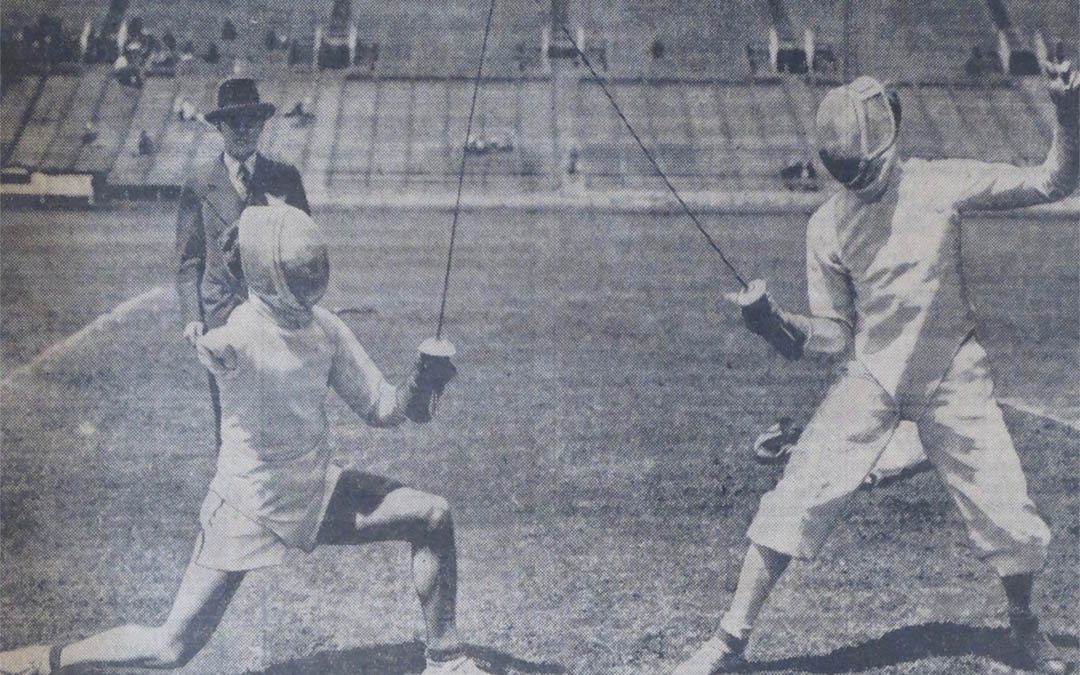
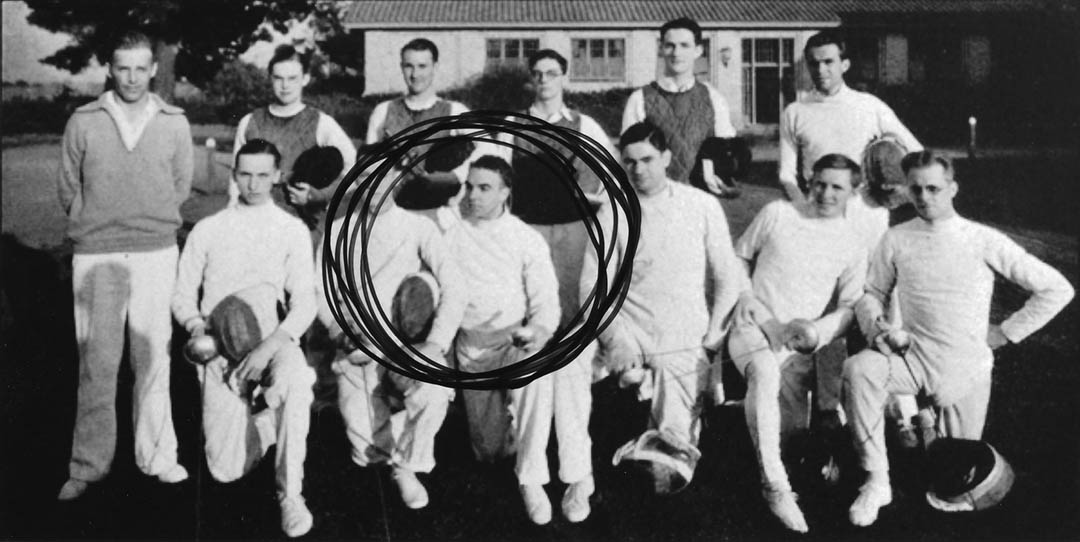
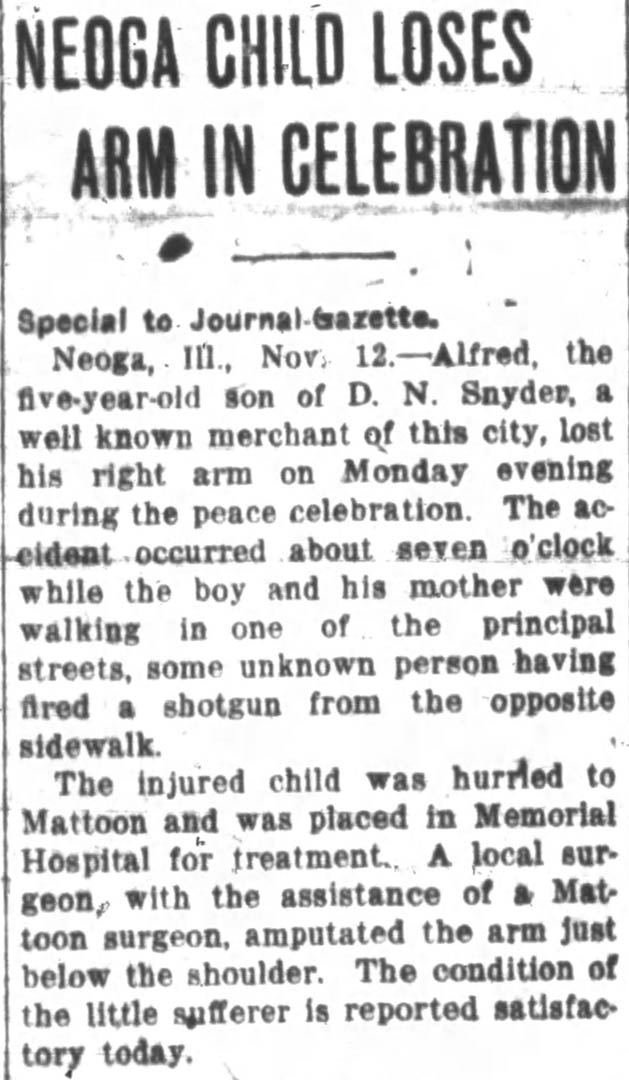
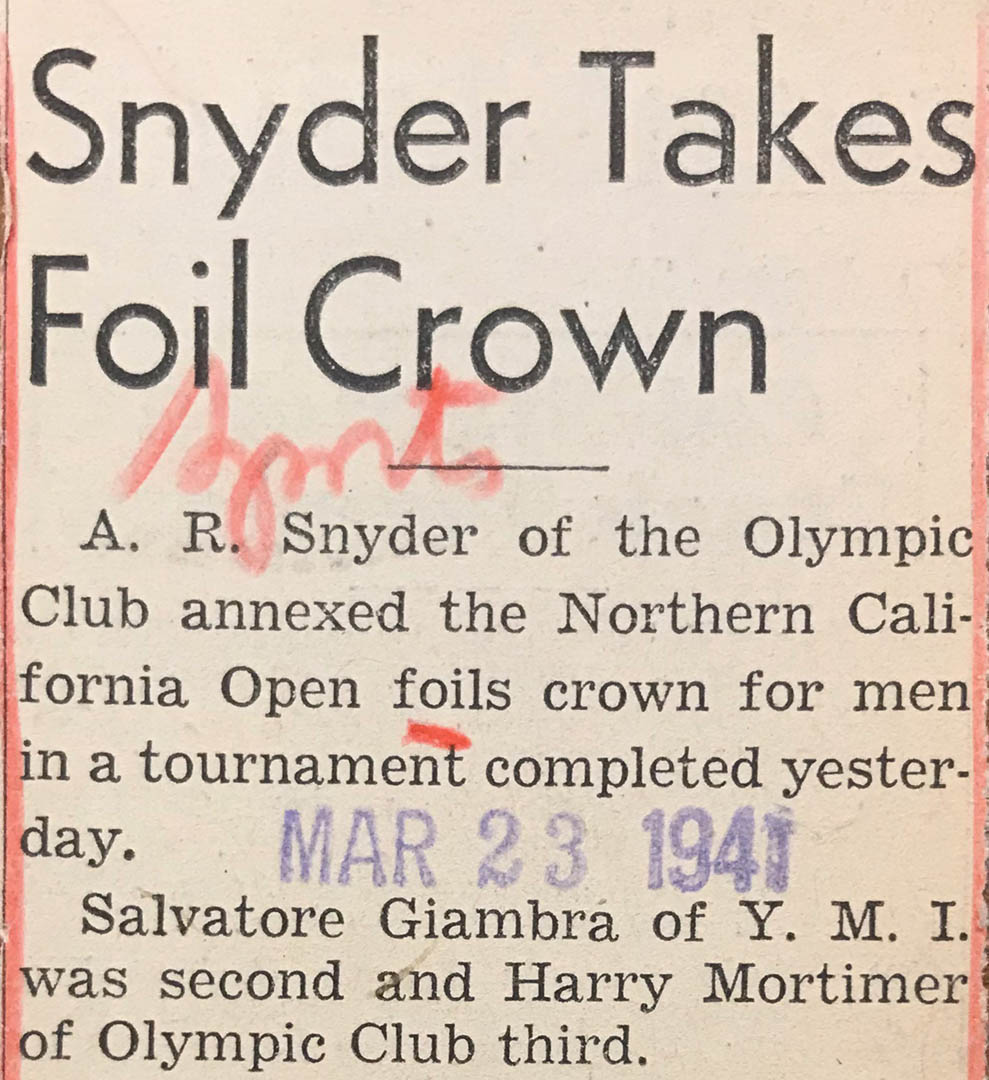
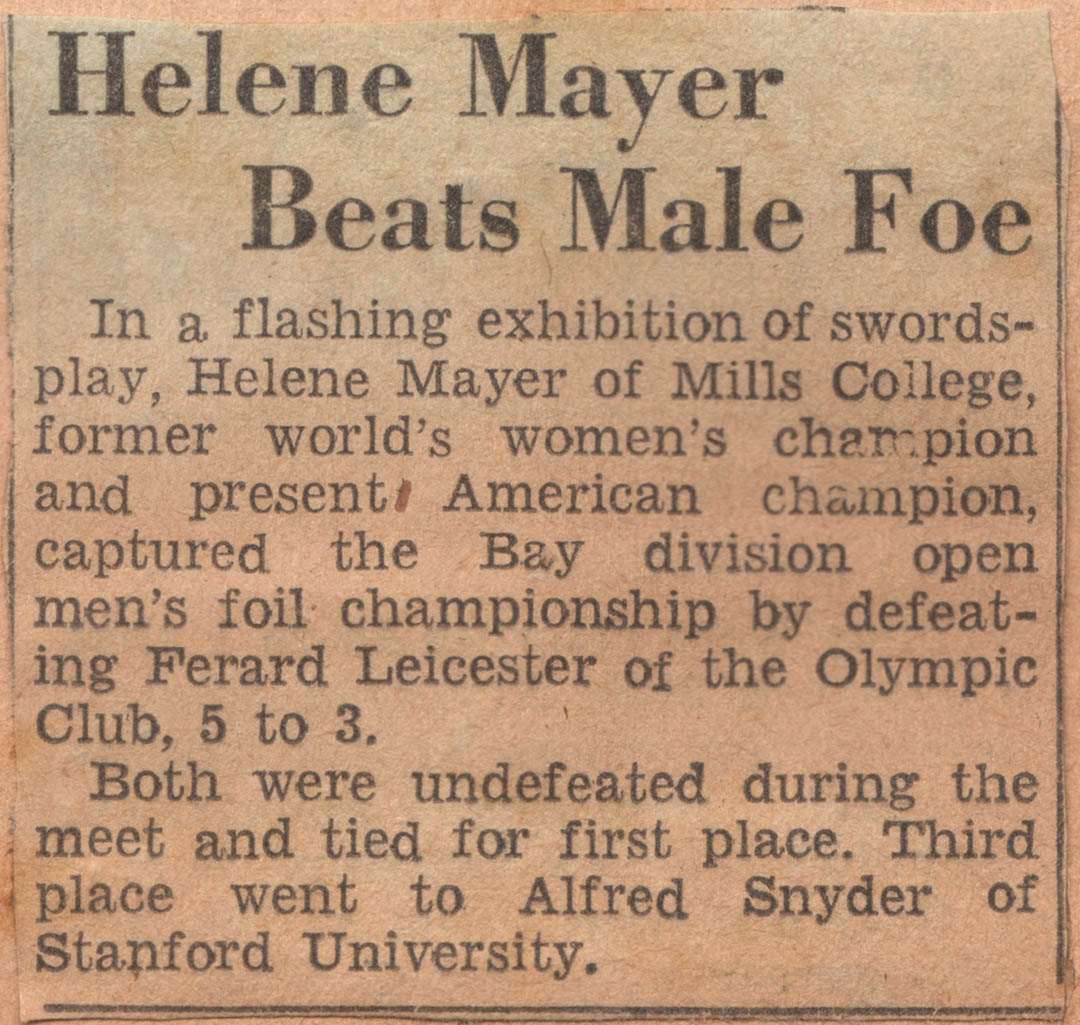

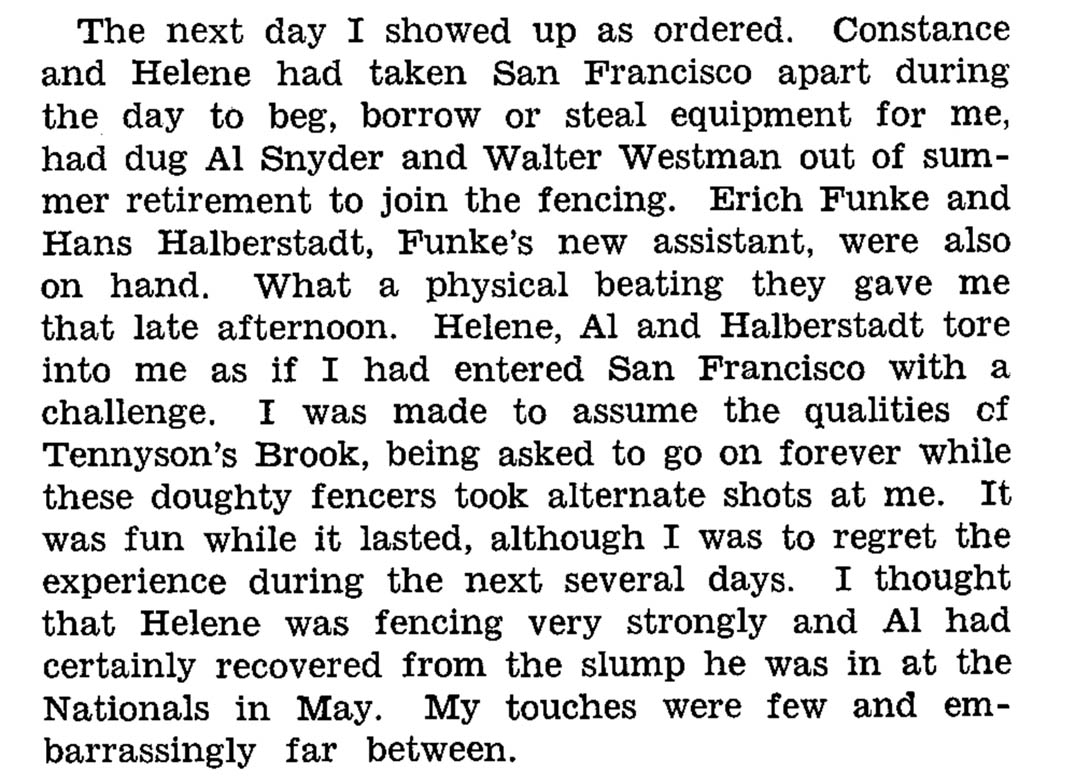
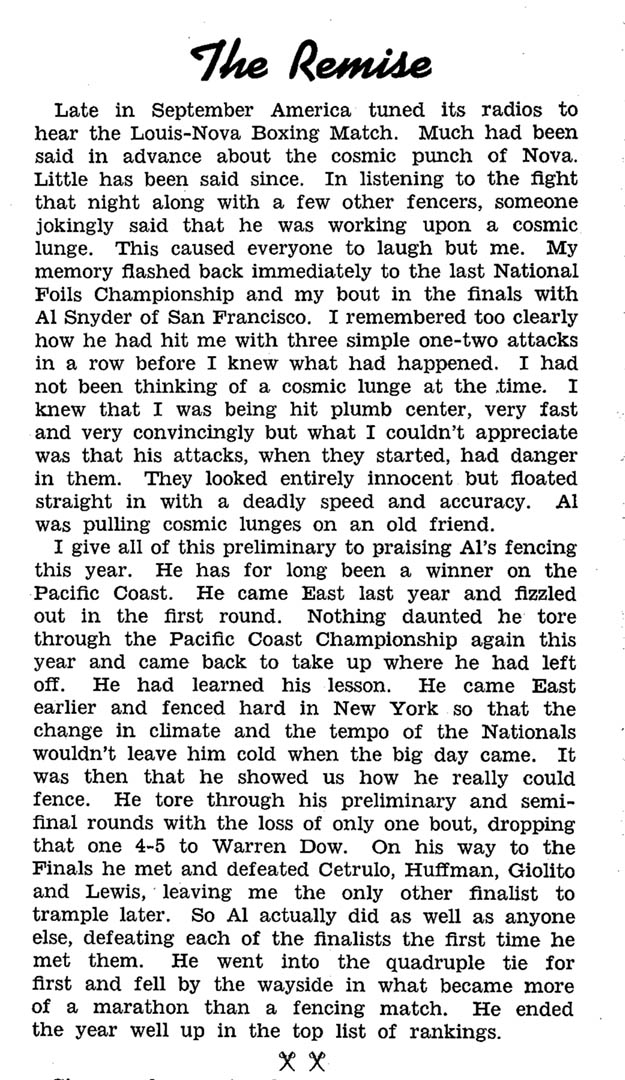
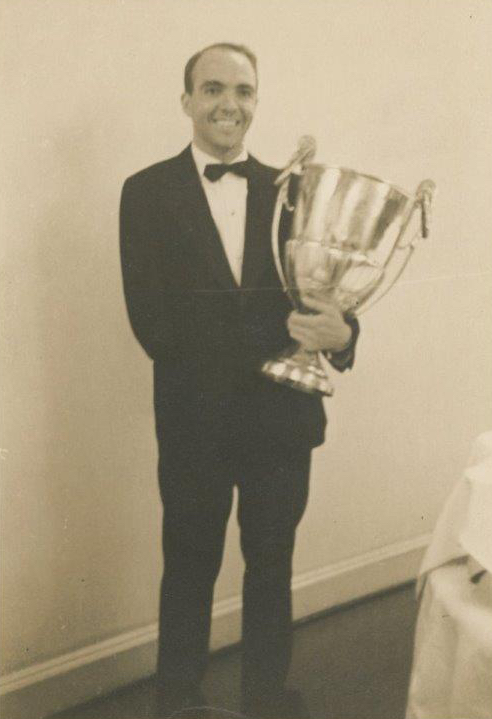
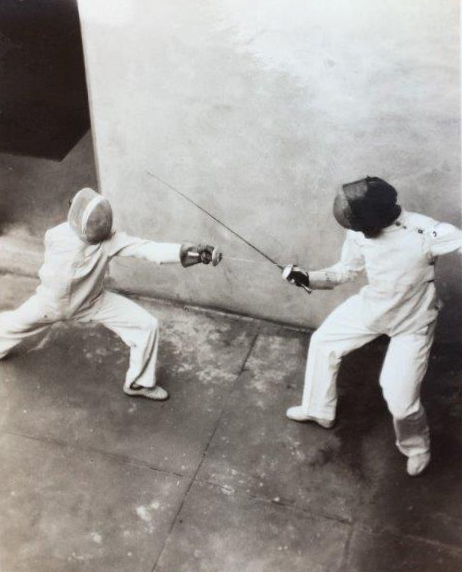
Dear Sir,
I liked very much this article. the reason of which is that , We would like to inform you that we Giorgi and Shalva Kokochashvili, from Tbilisi, Georgia, fencers (epee) from 1972 year. On 2016 we published book “Innovations and Inventions in Fencing” (English version).
The work (about 450 pages, English 1, 2 volume) is a encyclopedia, compilation of various pieces of information and contains a wealth of graphical material (some of which is being published for the first time), about fencing history, fencing weapons, fencing for disabled people, Georgian and other historical fencing; a description and explanation of existing fencing equipment and its evolution and innovations up to the present; fencing training devices; various worldwide inventions, including devices by the us-Kokochashvili brothers (specifically, new fencing handle designs and several training devices that can be used not only by fencers but in other kind of sport and by disabled or blind people; fencing equipment suppliers and other interesting and unusual information about famous people engaged in fencing, and much more besides.
The information about our book, was printed in the British magazine “The Sword” and also some references from the fencing experts: Giancarlo Toran (Italy), Malkolm Fare, Richard Cohen (UK) and etc. We also handover our book to FIE representatives: Evgeny Tsoukhlo, Mark Rakita, Elena Grishina, Paskal Tech, Augusto Bizzy, Semion Richtman, Stanislav Pozdniakov and etc. , also to Thomas Bach (President of IOC), when he visited Georgia. Our aim is to publish our work as a book and popularization.
In our book, we have a chapter, “left hand fencer”, article of which also was published in “academy.edu”.
May I get a permission, to use your material in my book, which we are updating, he volume became more then 500 pages. For now we also are in the stage to find a publisher of our book.
Thanks in advance for your support.
Sincerely,
Giorgi
In my report of US National Champions that’s on Andy’s web site, I have the following bio info about him:
Snyder, Alfred Rex (*1912-08-28 in Neoga, IL – †1997-09-18 in Webster, TX)
Based on his place of death, he moved to Texas. It was at least some time prior to 1970 because he’s mentioned in an article in the 1 Feb 1970 of the Austin American-Statesman taking second in a San Antonio electric foil co-ed competition and that he fenced in Houston. The article mentions that he’s a 57-year old, one-armed lefty who was 1944 national champion. There’s also a family tree that says that he married Yvonne Bersia in 1942 and they had a son named Michael David Guilliam Snyder in 1951 who may still be alive.
Hello, I am so excited to come across your research. I am Al’s granddaughtee and can put you in touch with his children who will have more info and photos.
Al Snyder went overseas after World War II in the shipping industry, first to Singapore, and then to Manilla, Phillipines. He and his wife Yvonne spent 12 years there and where they had three children. At the end of his expatriate contract period, he moved back to the New York offices of Kerr Steamship and lived in suburban New Jersey. I was his fourth child, born in Summit NJ.
Al remained active in the amateur fencing circuit in New York City into his 50’s. However, with the march of time, he decided that it was time to pick up a new sport, sailing. In 1967 we moved to Houston, where Al remained active in fencing and there was a Houston fencing club that met regularly into the 1970’s. As a young boy I would travel with my father to San Antonio, where Al competed in tournaments hosted by the US Army pentathalon team. I was always amazed that the skill of an old guy around 60 years old could whip the the speed and strength of youth. I also traveled with him to the US Fencing National championship in the early 70’s to Tucson (?) — though I don’t recall how well he did.
Another fencer, Jack Stafurik, may be able to give more details. You can find him on LinkedIn. Jack was engaged to my oldest sister at one point.
Meanwhile, I continued the love of sailing and sailboat racing, though did not pursue it at the top of the game. It just wasn’t a thing to become a professional sailor when I made life choices, as it is now.
Tim Snyder
I am his oldest daughter, Jacqueline. My brother, Tim, gave a pretty good account of the basic timeline of Al’s life.
I will add a few things…Al was recruited to the Stanford fencing team by a coach who saw him on the tennis court. As a child, while living in NJ, I saw that he was hard to beat either in tennis, or bowling. Al said that the way he won over the younger guys fencing was to just stand there and let them throw themselves on his foil. My impression is that he was just super quick, and that translated into everything he did. Additionally, he was a great diver.
Best of all, he kept in touch with all his friends over the years, writing and visiting regularly. An amazing and enviable life.
Thank you so much for your efforts and time spent looking for the details of an obscure but notable life. Jacqueline
Thank you so much for commenting on the story, Jacqueline!